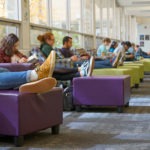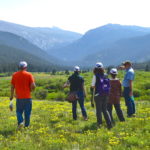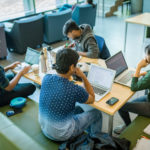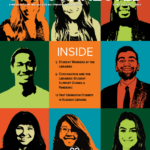By Jenna Allen
On September 8, 1968, descendants of Germans from Russia, who immigrated to America in the 19th and 20th centuries, gathered in Denver, Colorado. It was the first general meeting of people who were interested in creating a historical society for Germans from Russia.
“One of the tremendous jobs that we can do as a budding organization […] is to communicate, not only to our children, and children’s children, but also to others, what part the German-Russian people have played in the American way of life,” said John Werner, sketching a vision for the historical society.
“And it is a grand story. A great story,” he added.
That year, the American Historical Society of Germans from Russia was officially incorporated, and they began their educational and research mission to collect, preserve and share knowledge about their ancestors and culture before it vanished. The historic society now has more than 30 chapters across the U.S. and Canada, including one in Northern Colorado.
“Germans from Russia were one of the most significant groups of agricultural workers in Northern Colorado, and yet few people are familiar with the history of this group.” – Thomas Hasler (B.A., ’23), philosophy major
The history of the Germans from Russia began in 1763. At the invitation of Russian Empress Catherine the Great, German immigrants settled in Russia along the Volga River, about 500 miles southeast of Moscow. The monarch had promised them religious freedom, farmland, tax exemption, and more.
A century later, when Catherine’s descendants revoked these privileges, many German Russians immigrated to the United States. From the 1870s to the 1920s, these German Russians immigrated to Colorado, Kansas, Nebraska and the Dakotas to work on sugar beet farms. At the time, the sugar beet was a major cash crop in the region.
German-Russian families brought two valuable assets: their large, work-ready families and experience farming beets in a similar climate. Entire families, including young children, stooped over in beet fields became a familiar sight in the Northern Colorado landscape. Along with other immigrant fieldworkers, the German Russians were critical to the sugar beet’s success and Northen Colorado’s growth.
Thomas Hasler, a senior philosophy student, researched the sugar beet industry, and German-Russian, Hispanic, and Japanese farmworkers in Colorado, during an internship through CSU’s Extension program. “I think it is important to learn about the Germans from Russia because understanding their history is essential to understanding how we arrived at the Northern Colorado that we live in today,” he said.
Working in the beet fields (extract)
In 1977, history professor Kenneth Rock interviewed Peter Stoll, who was born in Russia and emigrated to the U.S. as a young man. In this extract, Stoll describes his work with Great Western Sugar Company. Listen to the full interview and read the transcript.
Learning about Colorado’s past to understand its present
Today, there are an estimated half million descendants of Colorado’s German-Russian immigrants, living mostly in Larimer and Weld counties. Some of those have been or are students at CSU.
When Peter Erickson, associate professor at CSU, asks students in his German classes why they chose a German class, students commonly respond that their grandparents or great-grandparents were German Russians and grew sugar beets.
Students, like Erickson’s, who are interested in German-Russian history often find historical materials are a gateway to engagement with globally relevant research topics, like immigration, economic development, transportation, natural resources, and labor.
Taylor LaPoint (B.A., ’22) researched the sugar beet’s contribution to the development of Northern Colorado in Windsor and Fort Collins during her Extension internship.
“Sugar beet farming contributed to the initial white settlement and economic development of the region, including rail lines to transport the beets,” she explained.
“Understanding sugar beets and Germans from Russia in Colorado is important for understanding one of the pillars of early Colorado’s economy.” – Taylor LaPoint, history alum
Sugar beets and workers also impacted a critical natural resource in Colorado: water. “In the 1940s, the Colorado-Big Thompson River Project was created, in part, as a result of farmers and factory executives lobbying for the need to prevent droughts on sugar beet farms,” said LaPoint. Today, the project annually diverts 200,000 acre-feet of water from the Western Slope to northeastern Colorado for the benefit of about 1 million residents and 600,000 acres of irrigated farmland.
Germans from Russia are discussed inside the classroom, as well as out in the field. In Fall 2021, Erickson taught a special undergraduate class, “Sugar and the American West.” Like Hasler and LaPoint, students examined the role of sugar beets in regional economic development and fieldworkers who contributed to the beet’s success. Students grappled together with course materials and discussions connecting local history with global issues of colonialism, race, capitalism, and labor.
According to Erickson, students say they now see Fort Collins with new eyes, and experience daily reminders of their learning when they look at local landmarks of sugar beet history, such as streets, churches, farms, and neighborhoods.
Wedding dance (extract)
An extract from a Russian-German wedding video, recorded in 1954. Watch the full video.
Decades of work to support learners and researchers
To support student learning and research, students and instructors need access to the CSU Libraries’ robust collection of materials related to Germans from Russia: photos, diaries, field reports, interviews, letters, financial documents, manuscripts, employment records, maps, amd more.
Both Hasler and LaPoint said the Libraries’ collections were important for their research. Hasler said he “spent a lot of time in the archives,” and LaPoint thought the oral histories in the collections were compelling.
“I always think it’s very valuable to hear people talk about their life experiences in their own words,” LaPoint explained.
The archival materials needed to support today’s students, like Hasler and LaPoint, have required decades of persistent effort, focus, and funding. One area of significant investment by the Libraries has been digitization, which greatly increases access to archival materials.
One of the earliest digitization projects at the Libraries, begun almost 25 years ago, was the Heitman collection. The collection contains historical and ethnographical materials, including oral histories, related to a 1970s study of Germans from Russia by CSU history professor Sidney Heitman.
In the years since the Heitman project, archivists have also added collections documenting the Germans from Russia experience, including the records of the Northern Colorado Chapter of the American Historical Society of Germans from Russia, two genealogical collections, along with recordings and oral histories documenting a special kind of polka enjoyed by Germans from Russia, known as the Dutch Hop.
An ambitious investigation into the possibility of digitizing more German-Russian materials was spurred by an international partnership, CSU’s International Center for German-Russian Studies.
From 2008 to 2016, CSU partnered with Saratov State University in Russia on collaborative research centers focused on the German-Russian communities in Russia and the U.S.
Among the key players were Janet Bishop, then coordinator of the Archives and Special Collections, and Kenneth Rock, emeritus history professor, who travelled to Saratov, Russia to meet fellow archivists and historians in the region of German-Russian settlements. The group explored the potential for collaborative digitization and academic research projects.
Although the partnership ended due to changes in Russian national politics, the project spotlighted the critical importance of archivists and historians in global research and information access.
A new generation of family support
Digitization projects can take a long time to complete, since digitization is labor-intensive and requires expertise.
When archivists receive physical materials, they painstakingly review each item individually to organize, preserve and store it properly. Typically, during this process, archivists may remove rubber bands, check for mold or damage, identify potential copyright issues, and flag personally identifiable information.
If an item is destined for digitization, that adds another step to the process. Simple, modern paper is the easiest to scan and digitize. Formats like audio, video or three-dimensional objects can require extra steps and specialized equipment.
Archives workers also gather information about each item so they can create metadata. Metadata are data that describe an item’s format, subject, appearance, creator, date, or other characteristics, so that researchers can find and understand these items.
Most critically, once materials are digitized and accessible online, they must be maintained and cared for so that students and researchers can use them in the future.
“Digitizing an item isn’t like adding a book to a shelf and it stays there,” explained Karen Estlund, dean of libraries. “With digitized materials, your shelf disappears every five years or so as server lifespans come to an end. You have to keep replacing the shelf, because the technology used to create that shelf changes and eventually becomes obsolete.”
“We need to make significant investments in long-term maintenance and updates so our learners and researchers will be able to use materials far into the future.” – Karen Estlund, dean of libraries
Recognizing this need, members of the Schwab family made a generous donation to support this work. Bill and Helen Schwab, formerly of Windsor, were active members of the Northern Colorado Chapter of the American Historical Society of Germans from Russia.
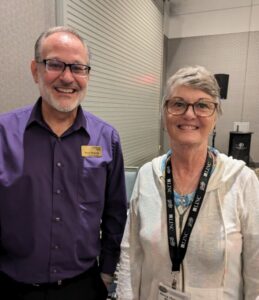
Bill’s parents, Jacob Schwab and Elizabeth Becker, had emigrated from Dönhoff, Russia, in 1907 and 1913, respectively. The couple’s nine children worked in the beet fields during the Great Depression.
Bill and Helen’s children, Tim, Roger, and Nancy grew up surrounded by German-Russia culture and made the donation in honor of their parents. They are still engaged with the community and the donated materials.
This summer, Roger Schwab visited Morgan Library and saw some of his parents’ materials for the first time, and learned about how impactful their donation of both materials and funding has been.
In the fall, Nancy (Schwab) Redshaw attended the annual conference of the American Historical Society of Germans from Russia. She enjoyed the presentation about the Libraries’ collections available to researchers, which was led by Mark Shelstad, head of digital and archive services, and Kenneth Rock, emeritus history professor.
The Schwab’s gift not only increases access to the collection through digitization, it also provides ongoing operational needs for Archives & Special Collections. That means that archivists and librarians can continue to current and future researchers and students can access this rich, globally relevant collection.

